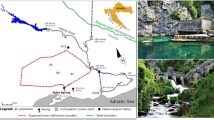Abstract
Electrical conductivity (EC) is widely used for monitoring the mixing of fresh water and saline water, separating stream hydrographs, and geophysical mapping of contaminated groundwater. The measured EC values at various temperatures need to be reported as corresponding to a standard temperature because EC is dependent on temperature. An arbitrary constant is commonly used for temperature compensation assuming that EC-temperature relation is linear (for example 2% increase of EC per 1 °C). This paper examines the EC-temperature relation of natural waters having vastly different compositions and salinities. EC-temperature relation was slightly nonlinear in a temperature range 0–30 °C, but the linear equation approximated the relation reasonably well. The temperature compensation factor corresponding to 25 °C ranged between 0.0175 and 0.0198.When the mean value 0.0187 was used, the error of estimating EC at 25 °C from EC at 10 °C was less than about 2% for all samples tested. Temperature compensation factors vary substantially depending on the choice of standardtemperature. Therefore, a care must be taken when standard temperatures different from 25 °C are used.
Similar content being viewed by others
References
Chang, C., Sommerfeldt, T. G., Carefoot, J. M. and Schaalje, G. B.: 1983, ‘Relationships of electrical conductivity with total dissolved salts and cation concentration of sulfate-dominant soil extracts’, Can. J. Soil Sci. 63, 79–86.
Clesceri, L. S., Greenberg, A. E. and Eaton, A. D.: 1998, Standard Methods for the Examination of Water and Wastewater, 20th ed., American Public Health Association, Washington, D.C.
Dingman, S. L.: 2002, Physical Hydrology, 2nd ed., Prentice-Hall, Upper Saddle River, NJ.
Frohlich, R. K. and Urish, D. W.: 2002, ‘The use of geoelectrics and test wells for the assessment of groundwater quality of a coastal industrial site’, J. Appl. Geophys. 50, 261–278.
Hem, J. D.: 1985, Study and Interpretation of the Chemical Characteristics of Natural Water, 3rd ed., U.S. Geological Survey Water-Supply Paper 2254.
Hiscock, K. M., Dennis, P. F., Saynor, P. R. and Thomas, M. O.: 1996, ‘Hydrochemical and stable isotope evidence for the extent and nature of the effective Chalk aquifer of north Norfolk, U.K.’, J. Hydrology 180, 79–107.
Jacobson, G. and Jankowski, J.: 1989, ‘Groundwater-discharge processes at a central Australian playa’, J. Hydrology 105, 275–295.
Jellison, R., MacIntyre, S. and Millero, F. J.: 1999. ‘Density and conductivity properties of Na-CO3-Cl-SO4 brine from Mono Lake, California, U.S.A.’, Internat. J. Salt Lake Res. 8, 41–53.
Jones, B. F., Eugster, H. P. and Rettig, S. L.: 1977, ‘Hydrochemistry of the Lake Magadi basin, Kenya’, Geochim. et Cosmochim. Acta 41, 53–72.
Keller, G. V. and Frischknecht, F. C.: 1966, Electrical Methods in Geophysical Prospecting, Pargamon Press, Oxford.
Kobayashi, D.: 1986, ‘Separation of a snowmelt hydrograph by stream conductance’, J. Hydrology 84, 157–165.
Korson, L., Drost-Hansen, W. and Millero, F. J.: 1969, ‘Viscosity of water at various temperatures’, J. Phys. Chem. 73, 34–39.
Lide, D. R.: 2000, CRC Handbook of Chemistry and Physics, 81st ed., CRC Press, Boca Raton, Florida.
Matthess, G.: 1982, The Properties of Groundwater, John Wiley & Sons, New York.
Millero, F. J.: 2001, The Physical Chemistry of Natural Waters, Wiley-Interscience, New York.
Plummer, L. N., Parkhurst, D. L., Flemming, G. W. and Dunkle, S. A.: 1988, ‘A Computer Program Incorporating Pitzer's Equations for Calculation of Geochemical Reactions in Brines’, U.S. Geological Survey Water Investigations Report, 88–4153.
Robinson, R. A. and Stokes, R. H.: 1965, Electrolyte Solutions, Butterworths, London, U.K.
Sorensen, J. A. and Glass, G. E.: 1987, ‘Ion and temperature dependence of electrical conductance for natural waters’, Analyt. Chem. 59, 1594–1597.
Yechieli, Y., Kafri, U., Goldman, M. and Voss, C. I.: 2001, ‘Factors controlling the configuration of the fresh-saline water interface in the Dead Sea coastal aquifers: Synthesis of TDEM surveys and numerical groundwater modeling’, Hydrogeol. J. 9, 367–377.
Zimmerman, E. P., Bentley, L. R. and Hayashi, M.: 2001, ‘The Verification of Electrical Resistivity Imaging in the Study of Saline and Fresh Groundwater Interaction at Lydden Lake, SK’, in Proceedings of the Second Joint Conference of the International Association of Hydrogeologists Canadian National Chapter and the Canadian Geotechnical Society, Calgary, Alberta, Canada, 16–19 September, pp. 952–958.
Author information
Authors and Affiliations
Rights and permissions
About this article
Cite this article
Hayashi, M. Temperature-Electrical Conductivity Relation of Water for Environmental Monitoring and Geophysical Data Inversion. Environ Monit Assess 96, 119–128 (2004). https://doi.org/10.1023/B:EMAS.0000031719.83065.68
Issue Date:
DOI: https://doi.org/10.1023/B:EMAS.0000031719.83065.68




